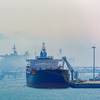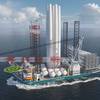DP Documents Revised, Published by IMCA
Two International Marine Contractors Association (IMCA) documents, often written into contracts by clients, have been fully revised and published. ‘Guidelines for the Design and Operation of Dynamically Positioned Vessels’ (IMCA M103 Rev 2), and ‘Guidance on Failure Modes & Effects Analyses (FMEA)’ (IMCA M166 Rev 1) are both now freely available on the IMCA website.
“Both important documents were reviewed using the IMCA ‘open forum’ web-based system introduced last year,” explains IMCA’s Technical Director, Richard Benzie. “This made for wide stakeholder engagement. All comments were welcomed and taken on board, so M103 and M166 can rightly be described as ‘updated by the wider industry for the industry’.
“’Guidelines for the Design and Operation of Dynamically Positioned Vessels’ (IMCA M103) has undergone a major re-write and now includes generic design and operational guidance, as well as vessel type-specific guidance for seventeen representative vessel types that utilize dynamic positioning (DP) in support of the offshore oil and gas and offshore energy industries – a feature we know the industry was eager to have included.
“The design guidance, based on IMO Circular MSC 645, focuses on the methods for creating fault-tolerant DP systems based on the principles of redundancy; operational guidance focuses on current good industry practice and draws from existing operational guidance from industry.
“The vessel type-specific guidance focuses on the industrial mission of the vessel and the impact that this has on its design and operation. A brief description of the industrial mission is included for each vessel in order to better explain the technical and operational guidance and to give an indication of the risks associated with an inability to maintain position.
“We are confident that M103, which was last revised in 2007, is right for the current era of DP vessels, and can be easily modified when needed, thanks to our decision to produce only pdf versions of all guidance documents,” he adds.
Focusing on M166
A failure modes and effects analysis (FMEA) is an easy to use yet powerful proactive engineering quality tool that assists in the identification and countering of weak points in the early design phase of products and processes.
The ‘Guidance on Failure Modes & Effects Analyses (FMEA)’ (IMCA M166 Rev 1) guidance document was commissioned by IMCA to highlight industry good practice in the use of FMEA techniques when applied to the technical systems associated with offshore vessels, in particular DP systems. It is an update of the original document IMCA M166 which was published in 2002. The four sections and appendices are designed to be read separately or as a single document.
“The document explains the history and development of FMEA and the role of FMEA in classification,” explains Richard Benzie. “Specifying an FMEA, the depth of FMEA reporting, the procedures used and the format of the final FMEA report are discussed. The additions to the FMEA process which can complement the analysis and the benefits of subjecting non-redundant systems to FMEA are also briefly explored.











